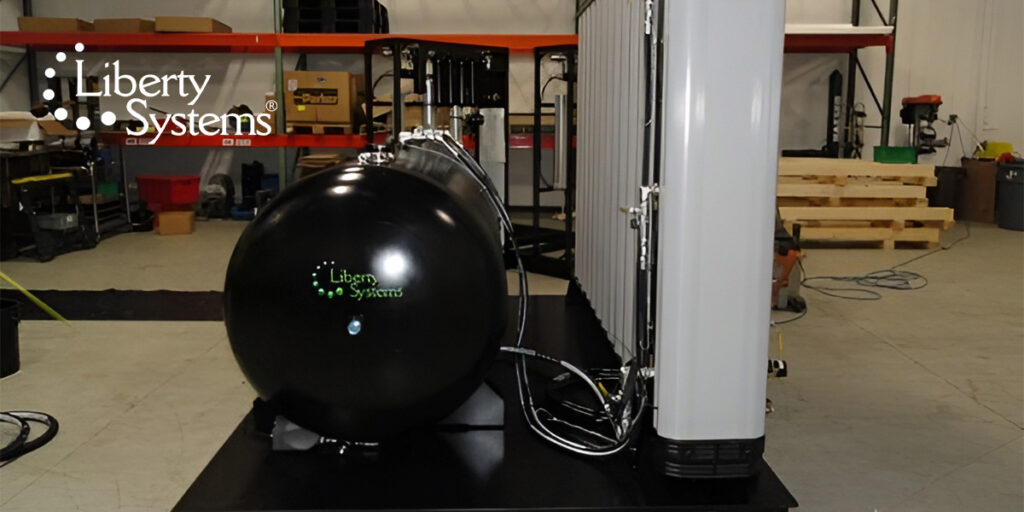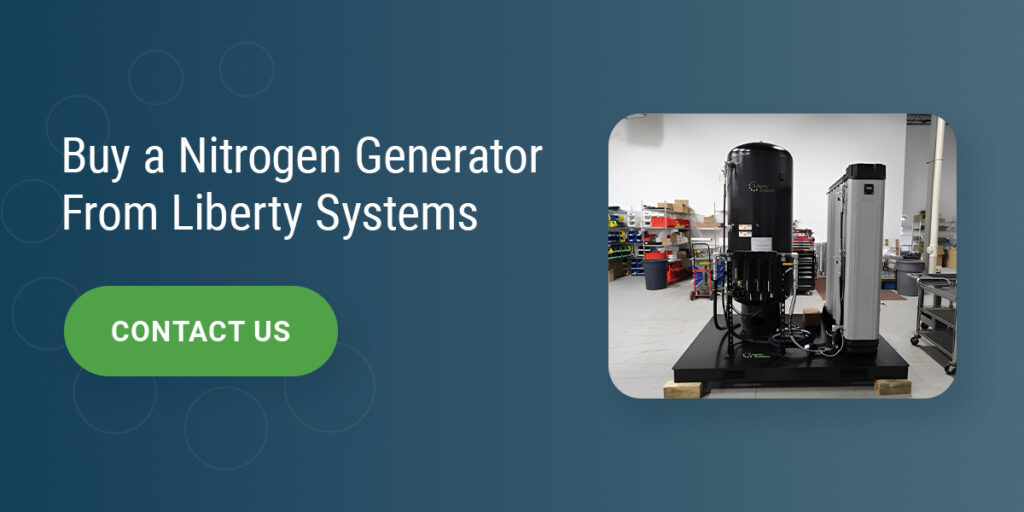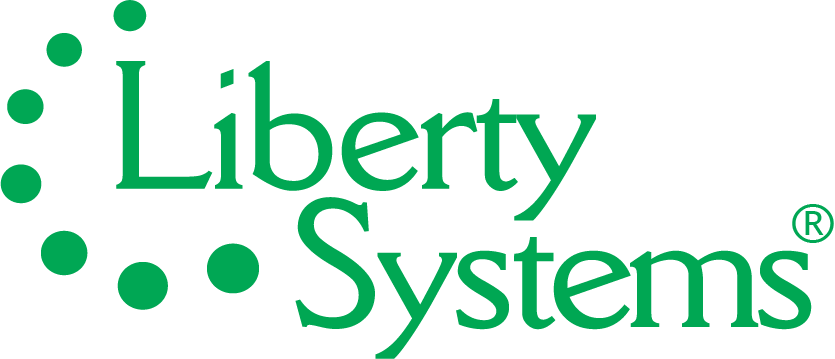PSA Nitrogen Generators vs. Membrane Nitrogen Generators

Multiple industries use nitrogen to perform core business operations. Business owners may rent liquid nitrogen tanks or high-pressure cylinders on an as-needed basis. However, there is a more cost-effective option.
The atmosphere is 78% nitrogen. You can harness this abundant resource with a nitrogen generator. These machines separate nitrogen from the air to provide nitrogen on demand.
The two types of nitrogen generators are pressure swing adsorption (PSA) and membrane generators. Choosing between the two depends on your nitrogen purity, pressure, and flow requirements. In this guide, you will learn more about the distinct types of nitrogen generation and how to find the right one for your application. It is best to collaborate with experts — like Liberty System Sales Engineers — to size it properly.
How Does a Nitrogen PSA Generator Work?
PSA generators separate nitrogen gas from compressed air by passing it through a carbon molecular sieve (CMS). These sieves have precise and uniform pores that absorb oxygen, carbon dioxide, water vapor, and other impurities. The nitrogen molecules bypass the CMS rather than being caught by it, at which point you can either collect and store or use the nitrogen immediately.
The CMS will eventually become saturated with oxygen molecules, which will prevent further gas separation. To ensure continual operation, PSA generators contain two CMS absorption beds. When one sieve bed becomes full, the generator switches to the other sieve bed. It then depressurizes and flushes the saturated CMS with nitrogen gas. This process removes the oxygen molecules from the sieve, which the generator releases as waste gas.
How Does a Membrane Nitrogen Generator Work?
Membrane nitrogen generators function by using a membrane separation technique. They contain semipermeable membranes made of hollow polymer fibers. While the PSA’s CMS absorbs oxygen, these membranes have a unique structure that allows select molecules to pass through. The air compressor pushes compressed air through the membrane and relies on the different gas permeability rates to separate the nitrogen from the other gases.
Once the nitrogen is separated from the oxygen and other gases, it is ready to use and apply to your process. The generator controls the pressure, purity, and gas flow through the system to ensure effective gas separation.
Key Differences Between PSA and Membrane Nitrogen Generators
PSA and membrane nitrogen generators each have their advantages and disadvantages. Understanding these and how the machines differ will help you choose one for your application. Below are the main differences and advice for choosing between the two types.
1. Purity Levels
The most essential factor to consider when choosing between PSA and membrane generators is the nitrogen purity levels. Nitrogen gas is considered either low or high purity depending on the ratio of nitrogen to oxygen. High-purity nitrogen has a 99.95% or greater nitrogen purity, while low-purity has a range of 90% to 99.9%. Ultra-high-purity nitrogen has a purity level of 99.999%.
Nitrogen generators offer varying nitrogen purity levels:
- PSA generators: Thanks to the effective CMS, PSA generators can produce high- and ultra-high-purity nitrogen. This resource is essential for industries and processes that are sensitive to oxygen and other contaminants. Examples include drug manufacturing, metal heat treatment and electronic circuit production.
- Membrane generators: Membrane generators produce nitrogen at a lower purity level — between 95% and 99.9% — making them suitable for low-purity nitrogen applications. These use cases include blanketing adhesives, food packaging, purging pipelines, and filling the ullage or vapor space above the fuel in a commercial jet.
2. Flow Rates

Nitrogen flow rate refers to the volume of nitrogen gas a generator can produce in a given period. It is measured in cubic feet per minute (CFM), cubic feet per hour (CFH), liters per minute (LPM), or cubic meters per hour (M3/h). Certain industries require more control over flow rate for safety and processing requirements. PSA and membrane generators offer different pressures, purities, and flow rates, which are essential to consider when choosing between the two.
- PSA generators: Industries requiring high flow rates and high nitrogen purity would benefit from a PSA generator. They offer effective flow rate control while maintaining purity.
- Membrane generators: Membrane generators achieve a reliable, steady flow at various rates. The benefit is a smaller footprint. You can control the flow rate by adding or removing membranes. However, higher flow rates can reduce nitrogen purity.
3. Energy Consumption
PSA and membrane generators all differ in their energy requirements. A nitrogen generator’s energy consumption increases with higher flow rates and purity levels. This increases operational costs and environmental impact. Consider the factors that affect energy consumption in each nitrogen generator type:
- PSA generators: PSA generators use less energy than membrane generators due to their lower air-to-nitrogen ratios.
- Membrane Nitrogen generators: Membrane generators are more economical when an application allows the use of lower-purity nitrogen. However, PSA generators are a more cost-effective option for obtaining higher flow rates and increased purity levels.
4. Maintenance
Another factor to consider when choosing between PSA and membrane generators is their maintenance requirements and costs:
- PSA generators: A PSA generator has multiple moving components that need regular maintenance to operate at peak performance and deliver their expected service life.
- Membrane generators: Compared to PSA generators, membrane generators are simpler systems with fewer points of maintenance.
5. Size
Finally, consider the space available in your facility, altitude and humidity levels before buying a nitrogen generator. If you have limited room in your floor plan, the footprint and height of the generator should be a key consideration.
- PSA Generators: PSA generators are usually larger than membrane systems thanks to their extra components, double CMS absorption beds, and higher-grade nitrogen output. They also have more complex installation requirements.
- Membrane Nitrogen Generators: If you need a lighter, smaller system, a membrane generator may be the best choice. These designs can be more compact and easier to install than PSA generators depending on their capacity.
Buy a Nitrogen Generator From Liberty Systems
Nitrogen generators equip businesses to reduce costs and meet their production demands. If you are in the market for a nitrogen generator for your business, the team at Liberty Systems is ready to assist you. Our Sales Engineers will assess your needs and help you choose the best model. We produce various designs at our ISO 9001:2015 certified facility, and we can also customize systems to suit unique requirements.
Our customer service does not stop after a sale. We have trained technicians who can support and service your generator and offer training so you know how to use and maintain it yourself.
Contact Liberty Systems today to discuss how we can serve your nitrogen generation needs.

